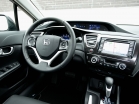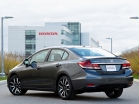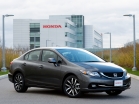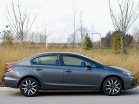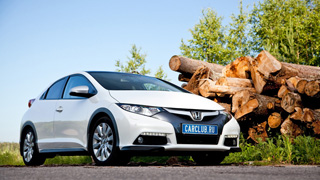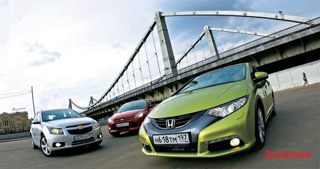Honda Civic sedan test drive since 2012 sedan
500 km on the road. Honda Civic Hybrid car test
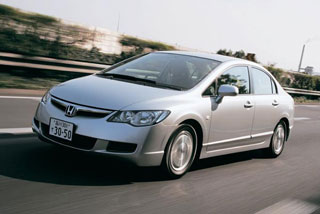 Honda Civic Hybrid Route First.
Honda Civic Hybrid Route First. In order to more or less feel what the new Civic Hybrid car is, I had to make a path of 500 kilometers long.
I started my trip with a site under the Tokyo Television Tower, walked with city streets, then went to the intracity speed road of Sutotak. Following it, I went to the Tokhoku Dzidzdoi suburban highway and reached the town of NAS. The first stage of the test trip ended here. The next stage ran along the public road Yamataka, who brought me first to Siohara, then to Nikko and Imaiti. The second stage ended on this. And finally, the third stage began in the center of Imaiti, then I ended up on the Nicco highway - Utsunomy, after which I again went on the highway Tokhoku Dzidosy and rushed towards Iokogama. The third stage ended directly under the Ferris wheel in the area of \u200b\u200bthe Jokogamsk port, which met me with the bright lights of evening lighting.
Before the start, I took a picture of the Tokyo TV tower and hit the road through the city streets. At a traffic light in the area of \u200b\u200bSiba Park, I turned and went to the intracity high -speed highway of the closet. I assumed that it, as often happens, would be clogged with cars, but this time I managed to go through the entire segment of the path at a rather high pace. Suffice it to say that the speed was held for 40 km/h, with the exception of those places where the cars moving along the road had to make up to let in automobile flows from the side.
To move along the banned city streets and intersections, the Civic car with a mixed type of thrust (hybrid) is perfect. This is already a universally recognized fact. If based on the testimony of the on -board computer, then at the initial stage of the way, fuel consumption, more precisely, the kilometer in terms of 1 liter of fuel was 12 km. But then the intensity of the movement increased, and therefore, on the site from the entrance to the Tokhokuto high -speed highway to the fork to Urava, this indicator grew to 16 km.
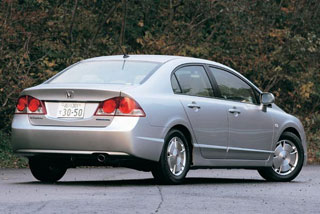 One of the distinctive features of the Civic car is a two -story arrangement of the indicators on the dashboard on the front panel. In the first upper row, there is a digital speedometer, an indicator of the amount of fuel in the tank and an analog fuel flow meter. The second tier is occupied by a huge tachometer dial. On the left side of the tachometer, the IMA control indicator and the indicator of the degree of discharge of the battery are visible. The IMA control indicator serves to inform the driver that the machine is on electric traction. And the digital pointer gives the driver a clear idea of \u200b\u200bhow the generator works and what is the residual battery capacity. All these devices are constantly in the field of view of the driver, so he does not need to be distracted from the road to find out certain parameters of the machine.
One of the distinctive features of the Civic car is a two -story arrangement of the indicators on the dashboard on the front panel. In the first upper row, there is a digital speedometer, an indicator of the amount of fuel in the tank and an analog fuel flow meter. The second tier is occupied by a huge tachometer dial. On the left side of the tachometer, the IMA control indicator and the indicator of the degree of discharge of the battery are visible. The IMA control indicator serves to inform the driver that the machine is on electric traction. And the digital pointer gives the driver a clear idea of \u200b\u200bhow the generator works and what is the residual battery capacity. All these devices are constantly in the field of view of the driver, so he does not need to be distracted from the road to find out certain parameters of the machine. Despite the fact that the car is moving on mixed traction, no disguise is felt. This is probably due to the fact that the main role in this mixed system still belongs to the internal combustion engine. That is why the driver can feel like driving an ordinary car. In particular, on a highway, the car shows a rather powerful traction. In size, the car goes beyond the small car, but since its weight is smaller, acceleration is more intensified. On the other hand, this is due not only to the good speed characteristics of the engine itself, but also by the fact that the electric motor included in the system can develop a powerful torque already in the early stages of movement, that is, at low speed. It turns out that the greatest torque is 10.5 kg/m, and it occurs in the speed range from zero to 1160 revolutions per minute. It is easy to guess how it affects the dynamics of acceleration. And yet, in terms of noise in the cabin, the Civic Hybrid car costs a step higher than to gather in the class.
At the entrance to the NUS, I got out of the car. Judging by the speedometer, then about 200 kilometers passed from the Tokyo Tower to this place. Almost all the way, when the speed reached the average level, IMA Honda system worked. Fuel consumption after the car went out of town, amounted to 19.2 km of run to a liter of fuel. As everyone must be known, on weekdays, the Tokhoka highway is not very loaded, so it was possible to move along it without special delays. Since there were few cars, I preferred to move with maximum permitted speed. But one could do otherwise, carefully following the instruments for ensuring that the machine would not go beyond the most economical regime. Then, I think, the fuel consumption could be even less, in the region of one liter on 20 km of path.
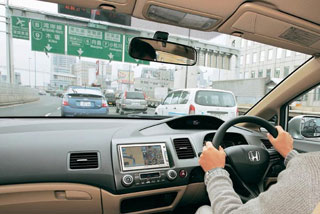 Honda Civic Hybrid Route number two.
Honda Civic Hybrid Route number two. The economy of the new Civic Hybrid car is largely due to the fact that the internal combustion engine is turned on only when the electric motor does not cope.
After my short -term stop at the entrance to the NAS, I had to do about 110 km on a general purpose road. The first half of the second stage was accompanied by constant and rather steep turns. In particular, the distance from the NUS to Sesseka is approximately 12 km. I decided to detect what fuel consumption in this area will be. As a result, it turned out that it grew to 18.2 km per liter of spent fuel. In this area, by the way, there is a protracted rise. So, when moving uphill, the flow meter stably showed about 10 km/liter.
Despite the fact that this stage was accompanied by frequent braking and accelerations, the car continued to demonstrate good exploring qualities. The ascents were overcome at a rather high pace. The engine turned out to be more speedy than in the Civic Hybrid car. Increased its presence and electric motor. While the internal combustion engine worked at low speeds, the electric motor actively helped him and, since his torque turned out to be significantly larger, even the coolest climbs were overcome very vigorously.
From the Borkeno highway (this is a paid section of the road connecting Nasu and Siohara), to cereal approximately 5 kilometers. But since a significant part of the path occupies a steep rise, the total fuel consumption increased sharply and compiled in terms of a kilometer of 17.3 km/liter. In many cases, the shooter readings of an instant flow meter were lower than 10 km/liter. Further, starting from cereal and up to Nikko, the road runs through a relatively flat terrain. Then, behind the scarlet line of Siohara, there is a series of lifting and descents, which ends in the Imaiti area. By the way, I had to move along the damp asphalt, because I scatter cold rain.
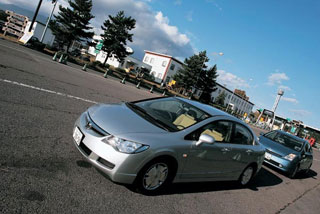 On this section of the route, the main thing I remember is that this is a very good grip of wheels with the road, despite the fact that the 195/65/R15 tires themselves were not the most suitable option for steep turns. And, nevertheless, being installed on the Hybrid Civic car, they allowed her to easily go through all the sharp turns at a rather high speed. It is safe to say that compared to the purely gasoline version of Civic, the car hybrid was better balanced. The front of the car acquired a noticeably larger weight. But what if you compare the current Civic Hybrid model with its predecessor? If you evaluate it in such a plane, then in a new car the driver began to feel more calm when he had to sharply twist the steering wheel, more informative steel and brakes. However, at dusk on the Yamataka highway, the front headlights turned out to be almost useless, so badly they illuminated the path in the dark. I think that the highest MX category is standardly equipped with xenon headlights is the right solution. But along with this, it would be advisable to provide headlights with a variable direction of the light beam, that is, the AFS system. Imagine, at dusk I almost ran into a deer! And so it was repeated twice.
On this section of the route, the main thing I remember is that this is a very good grip of wheels with the road, despite the fact that the 195/65/R15 tires themselves were not the most suitable option for steep turns. And, nevertheless, being installed on the Hybrid Civic car, they allowed her to easily go through all the sharp turns at a rather high speed. It is safe to say that compared to the purely gasoline version of Civic, the car hybrid was better balanced. The front of the car acquired a noticeably larger weight. But what if you compare the current Civic Hybrid model with its predecessor? If you evaluate it in such a plane, then in a new car the driver began to feel more calm when he had to sharply twist the steering wheel, more informative steel and brakes. However, at dusk on the Yamataka highway, the front headlights turned out to be almost useless, so badly they illuminated the path in the dark. I think that the highest MX category is standardly equipped with xenon headlights is the right solution. But along with this, it would be advisable to provide headlights with a variable direction of the light beam, that is, the AFS system. Imagine, at dusk I almost ran into a deer! And so it was repeated twice. After the car rolled under the slope, the average rate for fuel consumption began to improve again and reached the level of 17.6 km per liter. The new Civic Hybrid model is arranged in such a way that when the driver presses the brake pedal to stop, the automatic stop of the engine is turned on at idle. If, then, let go of the pedal, then the motor starts again. This happens with some time in time, and I still could not get comfortable for a rather long period of time. What else? When the machine reaches a certain speed mode, the internal combustion engine stops, and the movement continues only due to electric traction. This is an undoubted advantage of a new car, and in general, a very big step forward.
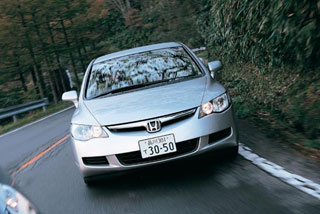 Passing Imaiti, I ended up on the highway connecting the city of Utsunomy and Nikko, and then again drove to the highway of Tokhoku Dzidosito. As already noted, the first half of the way I did not care too much about choosing the most economical regime. But when the time came to go back, I, wanting to save, decided to try. Therefore, I had to constantly monitor the readings of the devices. Thanks to my vigilant care at the entrance to Utsunomy, the average fuel consumption was already 17.9 km of the way per liter, and in the suburbs of Hasud this indicator reached a value of 18.5 km/liter.
Passing Imaiti, I ended up on the highway connecting the city of Utsunomy and Nikko, and then again drove to the highway of Tokhoku Dzidosito. As already noted, the first half of the way I did not care too much about choosing the most economical regime. But when the time came to go back, I, wanting to save, decided to try. Therefore, I had to constantly monitor the readings of the devices. Thanks to my vigilant care at the entrance to Utsunomy, the average fuel consumption was already 17.9 km of the way per liter, and in the suburbs of Hasud this indicator reached a value of 18.5 km/liter. When I was near the Ferris wheel in the area of \u200b\u200bthe port of Iokoham, 518 km was listed on my kilometer counter. As for the overall fuel consumption, my efforts were not in vain: it turned out to be almost 20 km for each liter of fuel (19.88 km/l, to be more precise). This is not surprising, because the car went all the way back with an average speed. And at the same time, the character of the road is not all, because, I think, the result would not be so good, do not strive to choose the most optimal speed mode. It is considered a universally recognized fact that the IMA system offered by Honda allows you to much reduce fuel consumption when driving along city streets. Here the new Civic Hybrid model has not opened anything fundamentally new to us. But at the same time, the Honda hybrid has become much more economical on suburban tracks. Moreover, according to this indicator, he came close to the Toyota Prius car.
Source: Auto-g.jp

